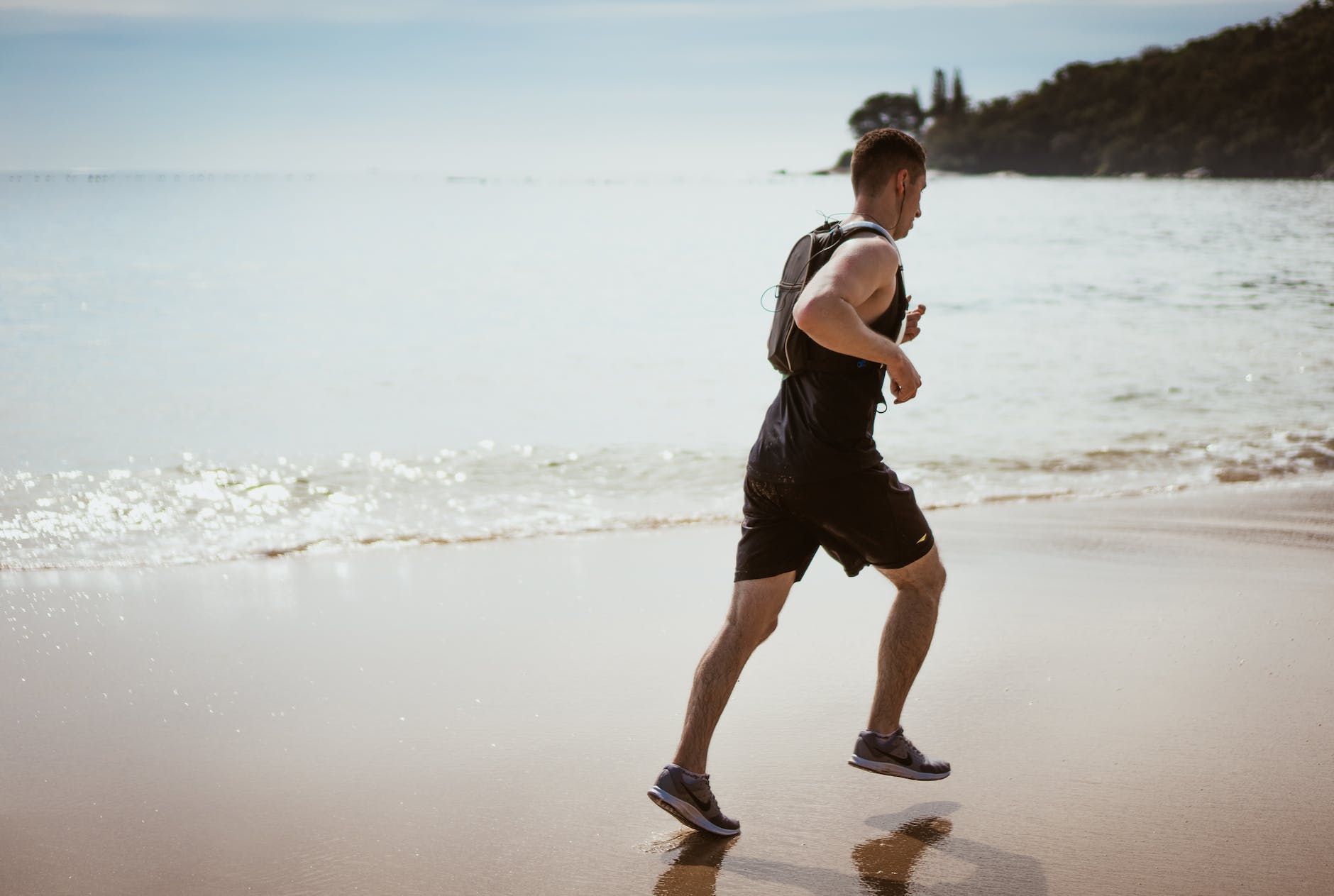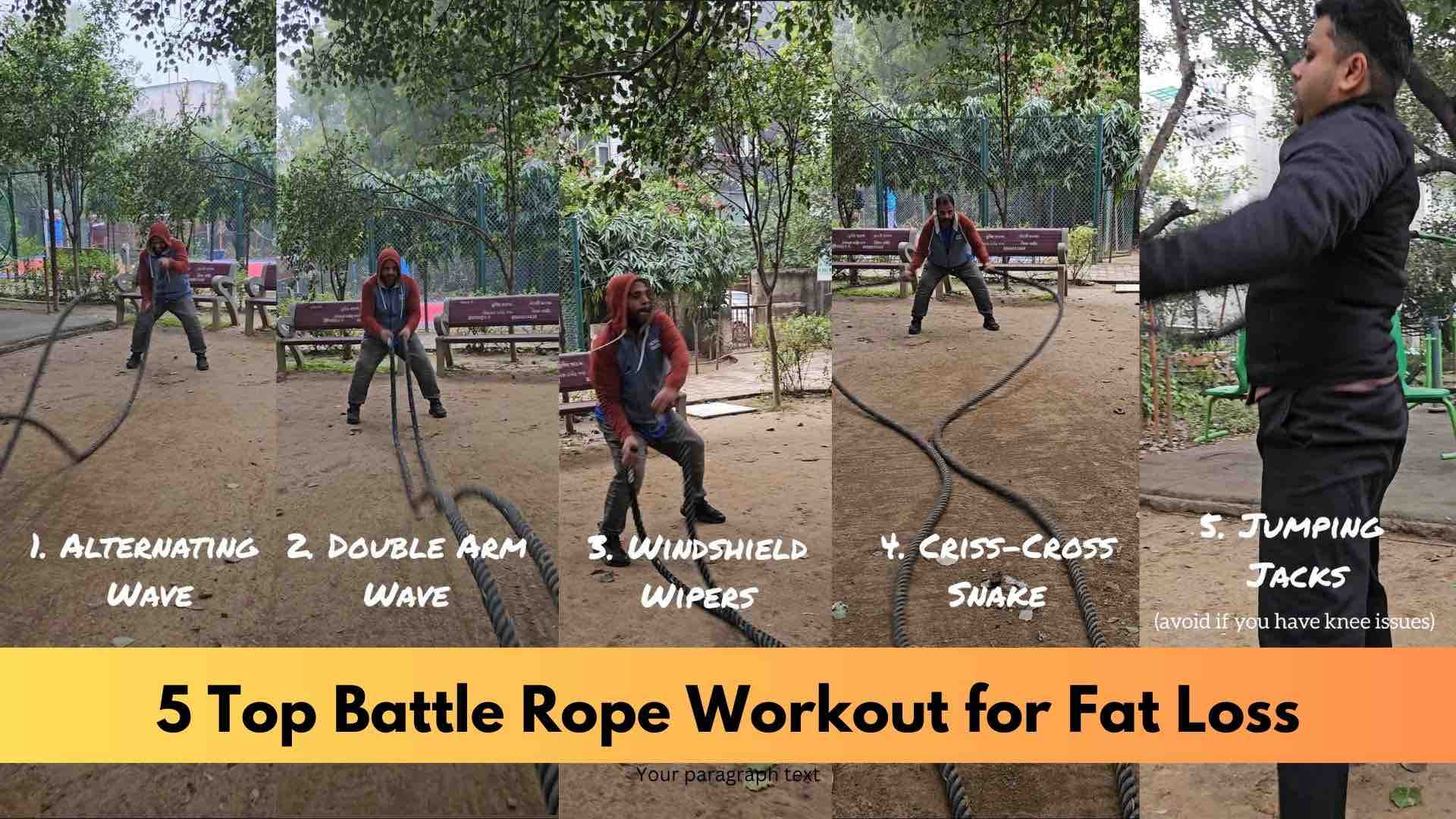
When I was struggling with my weight, tipping the scales between 125 to 130 kilograms at just 5 feet 5 inches, finding an effective and sustainable form of exercise was critical. With knee issues making walking or running challenging, I needed a workout that was intense yet gentle on my joints. Enter battle ropes for weight loss.
Battle ropes became my go-to workout because they offer a high-intensity, low-impact solution. This means they push your cardiovascular system hard without putting excessive strain on your knees, hips, or other joints—unlike activities like jogging or running. Surprisingly, I found battle ropes to be even more effective at raising my heart rate than traditional cardio exercises. They also engage upper body muscles that are often underutilized, making them a versatile and dynamic tool in any fitness routine.
What’s more, battle ropes are affordable, low-maintenance, and portable. Unlike bulky treadmills or rowing machines, they can easily fit in your car’s trunk, making them ideal for home or outdoor workouts. The only real limitation is the need for sufficient space to use them.
In this post, I’ll focus on five powerful battle rope exercises that have helped me shed fat, improve stamina, and engage those hard-to-reach muscles. These workouts are simple yet incredibly effective, combining strength, endurance, and fat loss into one seamless routine.
Here is a video of demonstration of the 5 Battle Rope Workout for Fat Loss that we are going to discuss.
Download Quick 5 Top Battle Rope Workout for Fat Loss Guide in PDF for immediate access on your device.
In this post, I’ll share:
- The benefits of using battle ropes.
- Top 5 battle rope exercises with a step-by-step guide.
- Essential tips for beginners.
- How to incorporate battle ropes into your workout routine for weight loss.
Also Read: 147 Kgs to 90 Kgs: 3 Lentils for Fat Loss Win
Benefits of Battle Ropes
- Full-Body Workout:
Battle ropes target multiple muscle groups simultaneously, including your arms, shoulders, back, core, and even your legs. - High-Intensity, Low-Impact:
They provide an intense cardio workout without putting stress on your joints, making them ideal for people with knee or hip issues. - Improves Cardiovascular Fitness:
Ropes get your heart rate up quickly, improving your endurance and overall heart health. - Builds Strength and Power:
The resistance of the ropes helps build muscle strength while improving explosiveness and stamina. - Burns Calories Fast:
Battle ropes can burn a significant number of calories in a short amount of time, making them effective for fat loss. - Portable and Affordable:
Unlike bulky gym equipment, battle ropes are compact, easy to carry, and relatively inexpensive. - Improves Coordination and Stability:
Many rope exercises require you to engage your core and maintain balance, enhancing coordination and overall stability.
Also Read: The Science of Protein: Maximizing Muscle Growth and Recovery
Top 5 Battle Rope Exercises for Fat & Weight Loss
1. Alternating Wave – Click Here to see a video demonstration.
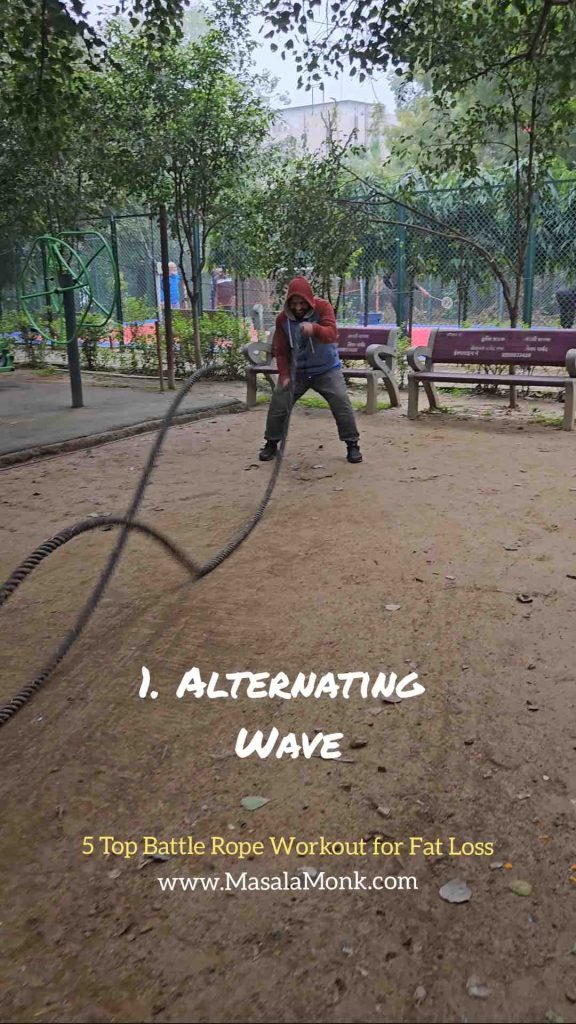
- Muscles Worked: Shoulders, biceps, core
How to Perform Alternating Wave Battle Rope for Weight Loss
- Stand with your feet shoulder-width apart, knees slightly bent, and core engaged.
- Grip the battle rope handles firmly with both hands, palms facing inward.
- Alternate raising and lowering each arm to create a continuous wave motion.
- Maintain a steady pace for 20-30 seconds, then rest for 10 seconds. Repeat for 3-4 rounds.
- Tips: Keep your back straight and avoid leaning too far forward. The waves should be smooth and consistent.
Also Read: Benefits of Nuts and Seeds – Protein-Packed Superfoods
2. Double Arm Wave – Click Here to see a video demonstration.
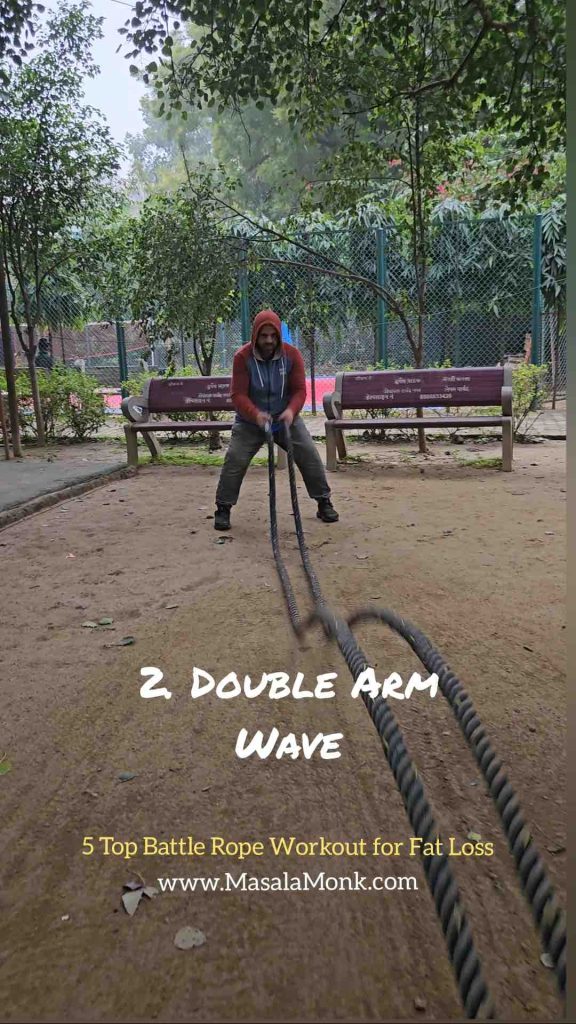
- Muscles Worked: Arms, shoulders, upper back
How to perform Double Arm Wave Battle Rope Exercise for Weight / Fat Loss
- Stand in the same stance as the alternating wave.
- Hold both rope ends and move both arms up and down together in a synchronized motion to create large waves.
- Continue for 20-30 seconds, followed by a short rest. Aim for 3-4 rounds.
- Tips: Engage your core throughout to avoid straining your lower back. Focus on generating power with your arms and shoulders.
Also Read: Bulletproof Coffee and Fasting: All You Want to Know
3. Windshield Wipers

- Muscles Worked: Obliques, core, shoulders
How to perform Windshield Wipers Battle Rope Workout For Weight / Fat Loss
- Stand with feet slightly wider than shoulder-width and knees bent.
- Hold the rope ends with both hands and swing them together in a semi-circular motion, mimicking windshield wipers.
- Alternate sides for 20-30 seconds, then rest and repeat for 3-4 rounds.
- Tips: Move your arms in a controlled manner and rotate your torso slightly to engage your obliques fully.
4. Criss-Cross Slam
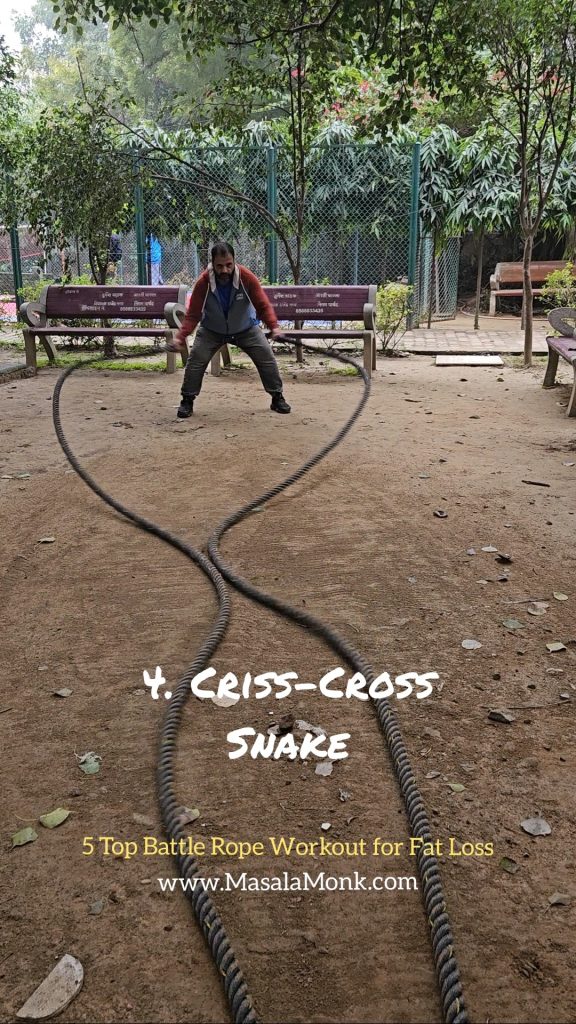
- Muscles Worked: Chest, shoulders, arms
How to Perform Criss Cross Snake or Slam Battle Ropes Workout for Weight Loss
- Stand with feet hip-width apart and knees slightly bent.
- Hold the ropes with both hands and cross them over each other, forming an “X” shape.
- Slam the ropes onto the ground with force, then uncross and repeat.
- Perform for 15-20 repetitions or 20-30 seconds, then rest. Repeat for 3-4 rounds.
- Tips: Focus on generating power from your upper body. Keep your movements explosive but controlled.
Also Read: Good Morning Yoga Routine: A Beginner’s Guide
5. Jumping Jacks with Ropes
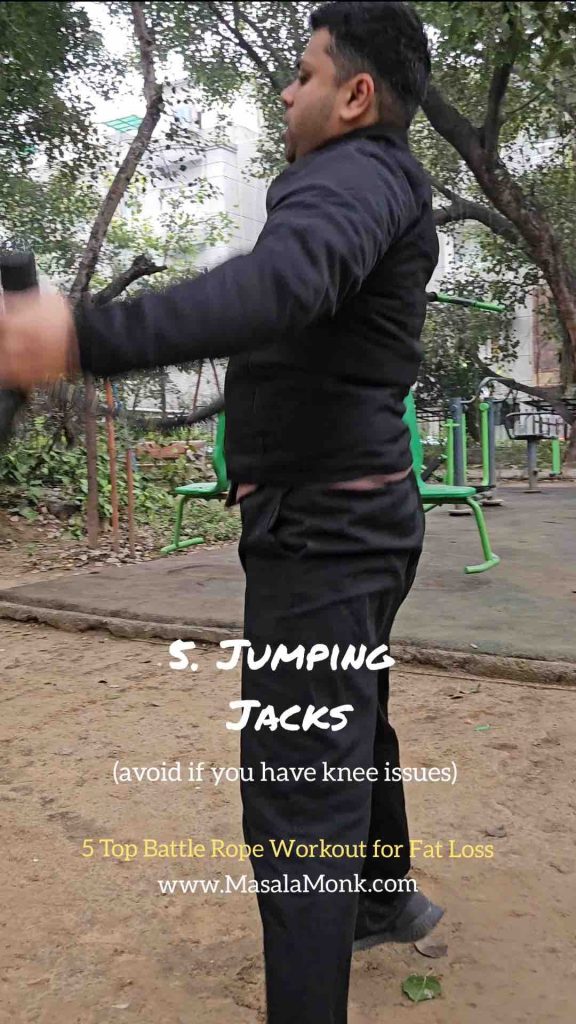
- Muscles Worked: Full body, particularly shoulders, core, and legs
How to Perform Jumping Jacks with Battle Ropes:
- Start in a standing position with the rope handles in both hands.
- Perform a jumping jack motion by spreading your legs and raising your arms simultaneously, creating waves with the ropes.
- Return to the starting position and repeat for 20-30 seconds. Rest, then complete 3-4 rounds.
- Tips: Land softly on your feet to minimize impact and maintain a steady rhythm for consistent waves.
Also Read: 28 Days AI-Powered Wall Pilates Challenge
Tips for Beginners
- Start Light:
Begin with shorter, lighter ropes to build your endurance and avoid injury. - Focus on Form:
Maintain a straight back, engage your core, and avoid locking your knees during exercises. - Pace Yourself:
Start with short intervals (15-20 seconds) and gradually increase your duration as you build stamina. - Warm Up and Cool Down:
Always warm up before starting and cool down afterward to prevent muscle strain. - Wear Proper Shoes:
Use supportive, non-slip footwear to maintain stability during workouts. - Stay Consistent:
Aim to incorporate battle ropes into your routine at least 3 times a week for the best results.
Also Read: How to Choose The Right Gym Shoes?
Incorporating Battle Ropes in Workout Routine for Weight Loss
- Cardio Circuit:
Pair 30 seconds of battle ropes with bodyweight exercises like squats, push-ups, or burpees for a full-body circuit. - Strength Training:
Use battle ropes as a finisher after strength sessions to maximize calorie burn and build endurance. - HIIT Workouts:
Perform high-intensity intervals with 20 seconds of all-out effort followed by 40 seconds of rest. Repeat for 5-10 rounds. - Active Recovery:
Use light waves or windshield wipers during active recovery days to keep your body moving without overexertion.
For quick access at gym or at areas without internet, you can download a small version of this 5 Top Battle Rope Workout Guide in PDF format and save it to your device.
Watch a short demonstration of 5 Top Battle Rope Workout for Fat Loss on YouTube.
Final Thoughts
Battle ropes are a fantastic tool for anyone looking to lose fat, build stamina, and strengthen their upper body. These five exercises are just the beginning—once you master them, you can experiment with different variations and routines to keep your workouts fresh and exciting.
Remember to maintain proper form and start at a pace that feels comfortable for you. Over time, you’ll notice improved endurance, greater upper body strength, and a higher level of overall fitness.
Happy training!
Ready to give battle ropes a try? Share your progress and experiences in the comments below—I’d love to hear how they work for you!
FAQs
- What are battle ropes, and how do they work for weight loss & fitness training?
Battle ropes are thick, heavy ropes used for fitness training. They provide resistance during exercises, engaging multiple muscle groups and improving cardiovascular endurance. - Are battle ropes suitable for beginners?
Yes, battle ropes are beginner-friendly. Start with lighter ropes and shorter sessions, gradually increasing intensity as you build stamina and strength. - How much space do I need for battle ropes?
You’ll need about 10-15 feet of open space to anchor the ropes and perform exercises comfortably. - Can battle ropes help with weight loss?
Absolutely! Battle ropes are a high-intensity workout that burns calories quickly and helps with fat loss while building muscle. - Do battle ropes work the lower body?
While primarily an upper-body workout, many exercises like squats and lunges with ropes engage the lower body as well. - How heavy should battle ropes be for beginners?
A rope weighing 1.5 to 2 inches in diameter and about 30-40 feet in length is ideal for beginners. - Can I use battle ropes at home?
Yes, battle ropes are portable and can be anchored to a sturdy object, making them ideal for home use. - What muscles do battle ropes target?
Battle ropes primarily target the shoulders, arms, chest, back, and core. Some exercises also engage the legs and glutes. - How often should I train with battle ropes?
You can incorporate battle ropes 3-4 times per week, depending on your fitness level and goals. - Are battle ropes safe for people with joint pain?
Yes, battle ropes are low-impact, making them a safe option for individuals with knee or hip issues. Always consult a physician if you’re unsure.

